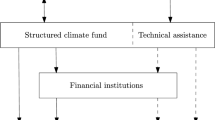Abstract
This paper considers the valuation and default exercise policy of risky coupon debt that is secured by a lease-encumbered noisy real asset. For parameter values used in our analysis, asset value noise is shown to reduce the value of waiting to default. Moreover, the borrower is shown to delay default exercise until the noisy signal of asset value is far into-the-money. This latter finding provides an information-based explanation for the apparent under-exercise of the mortgage default option that has been observed in the literature. An implication of this finding is that, if the claimholder recognizes that noise exists, but the empiricist—who is trying to compare observed exercise policy with that predicted by a noiseless model of asset prices—does not, a “sub-optimal” exercise policy may be inferred when in fact the policy is rational given the information available. This explanation is consistent with evidence from mortgage default studies as to why the observed default exercise boundary is lower than that predicted by standard theoretical option-based models.
Similar content being viewed by others
References
Case, K. E., and R. J. Shiller. (1989). “The Efficiency of the Market for Single-Family Homes,” American Economic Review 79, 125–137.
Childs, P. D., S. H. Ott, and T. J. Riddiough. (1997). “Bias in the Empirical Approach to Determining Risky Bond and Mortgage Premiums,” Journal of Real Estate Finance and Economics 14, 263–282.
Childs, P. D., S. H. Ott, and T. J. Riddiough. (2001). “Valuation and Information Acquisition Policy for Claims Written on Noisy Real Assets,” Financial Management 30, 45–75.
Childs, P. D., S. H. Ott, and T. J. Riddiough. (2002a). “Optimal Valuation of Noisy Real Assets,” Real Estate Economics 30, 385–414.
Childs, P. D., S. H. Ott, and T. J. Riddiough. (2002b). “Optimal Valuation of Claims on Noisy Real Assets: Theory and an Application,” Real Estate Economics 30, 415–444.
Grenadier, S. R. (1995). “Valuing Lease Contracts: A Real Options Approach,” Journal of Financial Economics 38, 297–331.
Grenadier, S. R. (1996). “Leasing and Credit Risk,” Journal of Financial Economics 42(3), 333–364.
Hull, J., and A. White. (1990). “Valuing Derivative Securities Using the Explicit Finite Difference Method,” Journal of Financial and Quantitative Analysis 25(1), 87–100.
Kau, J. B., D. C. Keenan, W. J. Muller III, and J. F. Epperson. (1990). “Pricing Commercial Mortgages and Their Mortgage-Backed Securities,” Journal of Real Estate Finance and Economics 3, 333–356.
Lipster, R. S., and A. N. Shiryayev. (1978). Statistics of Random Process II. New York, NY: Springer-Verlag.
Merton, R. C. (1973). “Theory of Rational Option Pricing,” Bell Journal of Economics and Management Science 4, 141–183.
Quigley, J. M., and R. Van Order. (1995). “Explicit Tests of Contingent Claims Models of Mortgage Default,” Journal of Real Estate Finance and Economics 11, 99–117.
Titman, S., and W. N. Torous. (1989). “Valuing Commercial Mortgages: An Empirical Investigation of the Contingent-Claims Approach to Pricing Risky Debt,” Journal of Finance 44, 345–373.
Vandell, K. D. (1992). “Predicting Commercial Mortgage Default Experience,” AREUEA Journal 20, 55–88.
Wheaton, W. C. (1990). “Vacancy, Search, and Prices in a Housing Market Matching Model,” Journal of Political Economy 61, 1270–1292.
Williams, J. T. (1993). “Equilibrium and Options on Real Assets,” Review of Financial Studies 6, 825–850.
Author information
Authors and Affiliations
Rights and permissions
About this article
Cite this article
Childs, P.D., Ott, S.H. & Riddiough, T.J. Effects of Noise on Optimal Exercise Decisions: The Case of Risky Debt Secured by Renewable Lease Income. The Journal of Real Estate Finance and Economics 28, 109–121 (2004). https://doi.org/10.1023/B:REAL.0000011149.04427.23
Issue Date:
DOI: https://doi.org/10.1023/B:REAL.0000011149.04427.23




